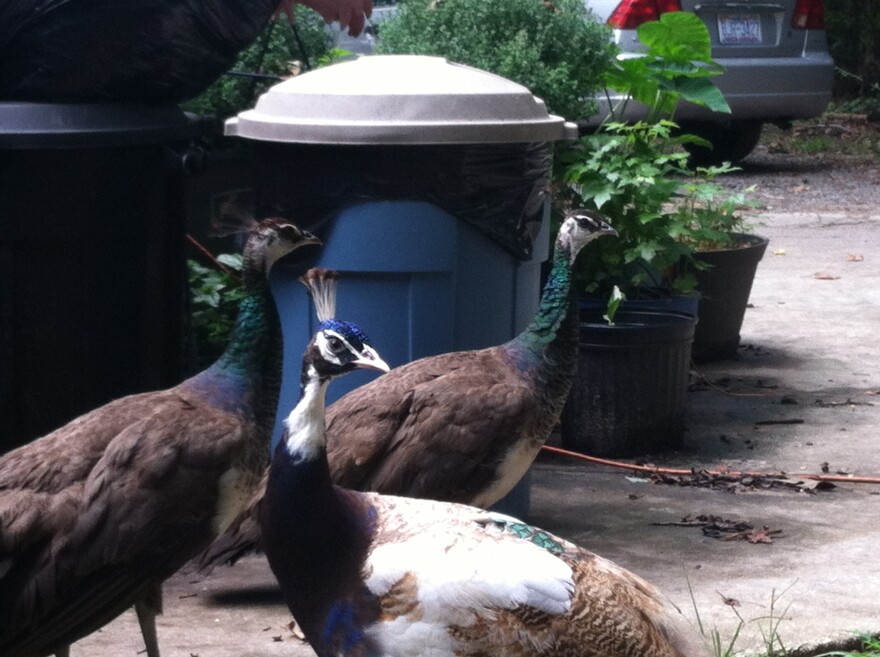When a guy goes out to the club, he might throw on his best clothes or a flashy chain or spike up his hair to impress the ladies. People call this “peacocking” after the birds who fan their colorful tails to attract mates.
But scientists are still researching what benefits peacocks get from their fashionable feathers.
Peacocks are notoriously noisy birds. So when I visited Noah’s Landing, a small zoo in Coats, North Carolina to record some peacocks and peahens - the girl birds - I figured something would happen quickly
I was wrong. And after two hot mid-morning hours of chasing peacocks and peahens with a microphone and nothing but some flapped wings and footsteps to show for it, I was a little miffed. I even busted out my best peacock call for nothing but a haughty glance from these fashionable birds.
By now you’re probably wondering why I spent a whole morning tailing peacocks. Scientists are trying to learn more about why peacocks have those curious tails, because in some ways those huge feathers make it harder for peacocks to survive. You wouldn’t try running away from a predator wearing a five hundred dollar suit. But those tails are useful for attracting peahens, just like that five hundred dollar suit may help get you a date by selling you as a “classy individual.” UNC Biology Professor Maria Servedio says this idea initially confused biologists.
"Darwin was the first one to point out that there were these traits that they couldn’t be explained by helping an individual survive, " Servedio says, "And so sexual selection is the reason he came up with that those things might be there."
That process of sexual selection breaks down like this. Some animals develop flashy appearances or sounds for the sole purpose letting others know that they are good breeding stock. When peacocks fan out their feathers, they’re saying to the peahens, “Hey! You should mate with me because I’ve got a HUGE tail!” Instead of survival of the fittest, it’s survival of the most fashionable. Servedio says, though that sexual selection is far from fully understood. We get that peahens like big peacocks, but we don’t get what the peahen thinks she’s getting from those broad feathers.
"So if females are preferring a certain type of male, do they get anything from it? Do they get direct benefits from the male? Or could there be indirect benefits, that they’re inheriting for their children?" Servedio says.
These questions are difficult to answer for certain, but a good place to start is to find out exactly what the peahens seek out in a male. That’s where Purdue University post-doc Jessica Yorzinski, who studies peahens comes in. During her dissertation, she was fascinated by eye-tracking technology, which allows researchers to see exactly what someone is looking at.
"I thought it would be a great idea to put it on the heads of birds to see what they were looking at," Yorzinski says.
That’s right. Peahen vision. Yorzinski and her team are the first to study mating behavior in this way. She spent months wrangling peahens. She attaches a helmet camera with Velcro and attaches a transmitter backpack underneath their wings. Then she puts the peahen in a pen with peacocks.
Yorzinski says the peahens focused on the peacock’s lower feathers, which she believes is because the peahens will check out the top feathers from far away and save the lower ones for a closer look. She is currently expanding her study to include how peahens look at clipped feathers and their predators. She is even putting the eye-trackers on the males to figure out what they look for.
Which brings us back to Noah’s Landing. The peacocks were not impressed by my blue-jeans, hiking boots and microphones. But after playing a YouTube clip of a peahen’s call, the boys livened right up. Calling and running and puffing up their depleted feather which they lose outside of mating season.
Even so, the resident peahens seemed uninterested and continued walking and eating bugs. Demonstrating how complex the biology of a single feather can be.
This story comes to us from UNC's School of Journalism and Mass Communication.






